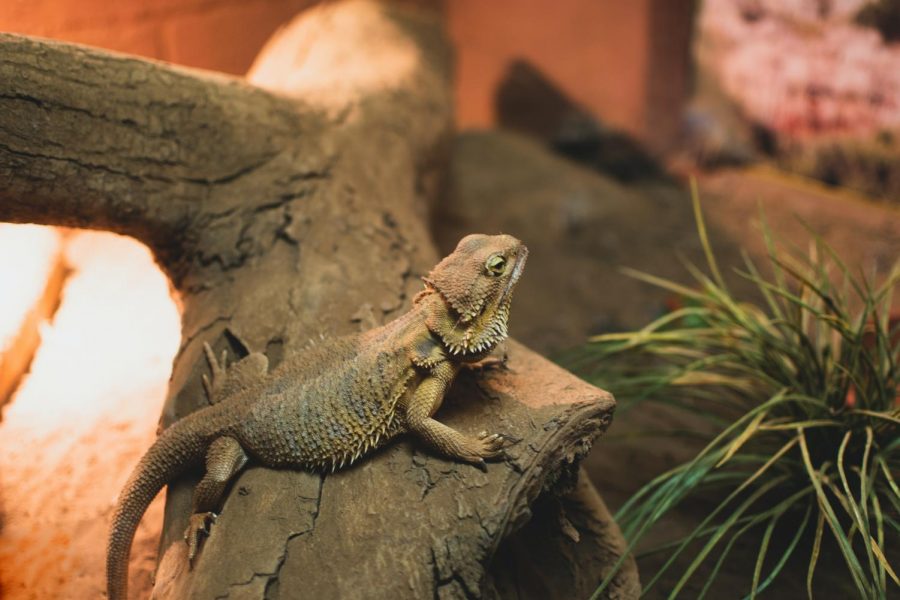The strange pets of FHC

More stories from Paulina Diesen
For freshman Penny O’Meara, it has become a new normal to warn her friends before they enter her home. Sneakily for those unprepared, her ferrets might surprise them when they first enter the house.
“I feel like [people that visit] are always a little scared [because] they do bite ankles, so that’s kind of scary for them,” Penny said. “People are usually kind of afraid, but they also want to hold them. They usually pick them up, and when they put them down, [the ferrets] run away.”
Although ferrets seem like a rare animal to have, they have been completely domesticated in North America. Luckily, Penny was able to find several different places to buy her ferrets from with the process of adopting a ferret being much easier than imagined.
“We got one of our ferrets at a pet store at first, but we were kind of skeptical about it because they’re not really the best; they don’t have the best reputation,” Penny said. “There’s a ferret rescue in Grand Rapids, and that’s where we got our second one. It was really easy, and they were really nice. It was great.”
Penny had always been interested in having a ferret, and after her family found out that her dad was allergic to both cats and dogs, she was able to convince her parents to buy her first pet: a ferret named Niffler. A few months ago, she was successful again after her parents agreed to let her get a second ferret, which she named Monkey.
Despite their unique features and strangeness, Penny found that ferrets are not very difficult to look after.
“It’s pretty basic [to take care of them],” Penny said. “They have a litter box, like a cat, and they can just run around. You don’t have to actually give them baths because they’re pretty clean, so they don’t get dirty really. And that’s pretty much it.”
They also have a much more basic diet than would be assumed for such strange creatures, with their diet consisting of cat treats and ferret food.
“They’re carnivores, so ferret food [consists of] little meat pellets,” Penny explained. “They don’t like plants, [and] they don’t like lettuce or fruit of any kind. They really like raw salmon, salmon oil, and other similar foods.”
Ferrets are also very easy to take care of due to their calm nature. Penny’s ferrets sleep for almost twenty-two hours a day, with their most active hours being right after they are taken out of their cage. They tend to sleep through the night just like humans, and they’ve become Penny’s new roommates.
“I do sleep with them,” Penny said. “They really like my bedroom in particular, so they’ll sleep with me. They have gotten stuck in the mattress part of my bed, but they can get out, which is kind of weird. They just know their way out, so we don’t really have to worry about that. Usually, they sleep toward my feet, so [I] don’t have to worry about crushing them with [my] upper body, but I do have to check my bed before I lay down in case they’re there.”
Unsurprisingly, Penny is not the only student at FHC who has a bizarre pet. Freshman Emma Von Tongeren has her fair share of strange pets as well. Although horses are wildly popular to, Emma has two horses that she owns that take up most of her time.
“My two horses are named Remi and Vinnie,” Emma said. “Remi is what you call an appendix, which is a really odd name for a horse. And then the other one, Vinnie, is a Holsteiner.”
Along with her horses, Emma also has a dog and a bearded dragon.
“I really wanted a lizard when I was young, like eight years old maybe, and finally my mom gave in and bought me a lizard,” Emma said. “And then, for the horses, we had our trainer search around in the area because we didn’t know how to find a good one.”
Before even owning her two horses, Emma has been riding for around three and a half years and even inspired her mother to ride as well. Horse riding, a difficult activity in itself, requires a lot of preparation that Emma has to do before riding them.
“You have to bathe them in the summer, make sure they’re clean before you ride them—so brush them off—and you have to pick their feet out to get the dirt out from their hooves,” Emma said. “And tack them up, so put your saddle on, and you have to exercise them. Once you get off, you have to cool them down and make sure they’re cool because if they go into their stall and they’re not cool, they could get sick.”
While being demanding in cleaning and the time necessary, Emma finds riding her own horses to be physically difficult as well.
“I didn’t realize it was going to be so hard,” Emma said. “At first, I thought it was going to be just sitting on top of a horse and riding around, but it requires a lot of leg strength. I get sore pretty often.”
Not only do horses take a lot of effort, but they also take a lot of time. Emma spends approximately ten hours a week at the barn. Every time she visits the barn, it is at least a two-hour visit.
But her love of her horses makes all the extra time and effort worth it. The time spent with her horses has built a strong relationship with them, and she is able to see the personality in her horses. Her first horse has a very distinct personality that Emma has come to embrace.
“Remi is super funny and super sweet,” said Emma. “He has huge ears like a bunny rabbit. They kind of look like donkey ears, so we always joke that he has donkey ears. He likes to stick his tongue out. We’ll walk up to him, and his tongue is just out, and he’s just a really nice horse; he’s really sweet.”
Her other horse, Vinnie, has also let his true personality shine through as Emma has gotten to know him.
“My other horse is a little bit more naughty,” Emma said. “The one we just bought—he’s a biter [but] just a little bit. So, after I’m done riding him, he’s done. He wants to go back, he wants to go eat his food, and [he wants to] see his friends. That’s when he gets a little bit more grumpy, shaking his head, and I can tell he needs to be done.”
And even beyond her horses, Emma’s lizard, Thorn, requires her time as well. Unlike her horses though, he requires very little attention—definitely not ten hours a week. And when he does need more time, it often relates to the unique grooming required for lizards.
“He sheds,” Emma said. “He shed a lot more often when he was a baby, but he does still shed. He just kind of does it on his own. If there are pieces that won’t fall off, I’ll put him in a warm bin of water because that helps it fall off. I try not to pull it off his skin, but if there are some in his cages, I try to make sure and pick it up. We try to clean his cage once a week; sometimes we end up leaving it for a few weeks, but we try to do it once a week.”
Through interactions like this and just quality time with Thorn, Emma has come to realize that pets have their own personalities. Emma’s horses have their own unique traits, but her lizard Thorn is also full of quirks.
“To temperature regulate, he opens his mouth, so it kind of looks like he’s singing in his cage,” Emma said. “So, I’ll walk up and he’s [got his mouth wide open]. I don’t know why they do that.”
AP Lang teacher Anne Keller has not noticed this peculiarity in her chameleon, Leon, nor in her bearded dragon, Lamont. But, like Emma, Keller has found that bearded dragons are not very difficult to take care of. Her chameleon, on the other hand, requires more attention.
“Bearded dragons are easier to care for because they are not as sensitive,” Keller said. “They eat crickets or mealworms and veggies, need water, and cleaning of the substrate in their tank. Chameleons are more challenging to care for because they need a certain level of humidity in their habitat. They eat the same kinds of foods [with] fewer veggies, though, [but] Leon does like his pothos plant. You have to monitor the temperature more closely [as well].”
In spite of the differing levels of attention, Keller still deeply cares for both of her pets, even if they are considered unique and sometimes more difficult. She has become used to the attention necessary, and she even hosted a gender reveal for Leon last year.
“It’s been interesting to watch Leon grow,” Keller said. “We had a gender reveal party for him last year when I taught 6th grade. Since he was a young lizard when I got him, we had to wait a bit, but you can tell if a chameleon is a male by looking at its hind feet.”
Moments like these are irreplaceable for Keller, making reptiles as sweet as any traditional pet. Overall, she recommends reptiles as pets, but she also gives a fair warning to all to be prepared to take care of these creatures for a lengthy amount of time.
“Reptiles can be great pets, but you should expect that they [will] live a long life,” Keller explained, “and [you should] be prepared for the responsibilities that these reptiles require. I got Lamont because a student suggested getting a bearded dragon for the class. 17 years later, he’s still going and has been in every one of my Forest Hills classrooms. Students I had in French 6 years ago at Ada remember him, and he even went home with some students during the summer.”

Paulina Diesen is a sophomore entering her first year as a writer for The Central Trend. She loves writing and is excited to have her work published....



























































































